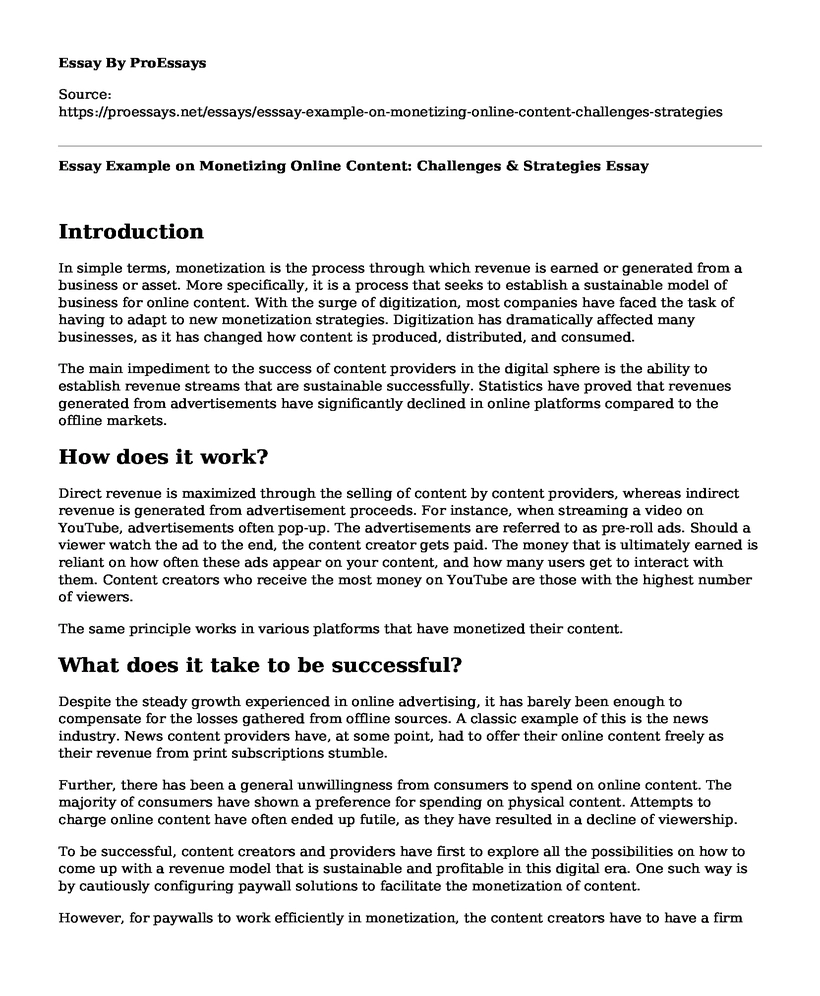Introduction
In simple terms, monetization is the process through which revenue is earned or generated from a business or asset. More specifically, it is a process that seeks to establish a sustainable model of business for online content. With the surge of digitization, most companies have faced the task of having to adapt to new monetization strategies. Digitization has dramatically affected many businesses, as it has changed how content is produced, distributed, and consumed.
The main impediment to the success of content providers in the digital sphere is the ability to establish revenue streams that are sustainable successfully. Statistics have proved that revenues generated from advertisements have significantly declined in online platforms compared to the offline markets.
How does it work?
Direct revenue is maximized through the selling of content by content providers, whereas indirect revenue is generated from advertisement proceeds. For instance, when streaming a video on YouTube, advertisements often pop-up. The advertisements are referred to as pre-roll ads. Should a viewer watch the ad to the end, the content creator gets paid. The money that is ultimately earned is reliant on how often these ads appear on your content, and how many users get to interact with them. Content creators who receive the most money on YouTube are those with the highest number of viewers.
The same principle works in various platforms that have monetized their content.
What does it take to be successful?
Despite the steady growth experienced in online advertising, it has barely been enough to compensate for the losses gathered from offline sources. A classic example of this is the news industry. News content providers have, at some point, had to offer their online content freely as their revenue from print subscriptions stumble.
Further, there has been a general unwillingness from consumers to spend on online content. The majority of consumers have shown a preference for spending on physical content. Attempts to charge online content have often ended up futile, as they have resulted in a decline of viewership.
To be successful, content creators and providers have first to explore all the possibilities on how to come up with a revenue model that is sustainable and profitable in this digital era. One such way is by cautiously configuring paywall solutions to facilitate the monetization of content.
However, for paywalls to work efficiently in monetization, the content creators have to have a firm grip on their consumers. The creators have to ensure that the content they produce is unique, and their consumers cannot access it elsewhere. Providing a brand that is strong and can be trusted, goes a long way to ensuring success.
Conclusion
Relying on a paywall alone as a solution to monetization can prove ingenious since it relies on an established consumer base while turning away prospective ones. To facilitate this, the option of distributing monetization through several digital platforms comes along. Content providers should be able to meet the needs of different consumers. They could rely on the paywall, offer a subscription option, direct payment, use of micropayment, etc., to give consumers the option of selecting what they prefer. By capturing rod multitudes, the success of monetization is almost guaranteed.
References
Aral S, Dhillon P (2017) Digital paywall design: implications for subscription rates & cross-channel demand. SSRN working paper 2906530. https://ssrn.com/abstract=2906530
Berger B, Matt C, Steininger DM, Hess T (2015) It is not just about competition with "free": differences between content formats in consumer preferences and willingness to pay. J Manag Inf Syst 32:105–128. https://doi.org/10.1080/07421222.2015.1095038
Davoudi H, An A, Zihayat M, Edall G (2018) Adaptive paywall mechanism for digital news media. KDD '18: the 24th ACM SIGKDD international conference on knowledge discovery & data mining. ACM, New York, pp 205–214
Lambrecht A, Misra K (2017) Fee or free: when should firms charge for online content? Manag Sci 63:1150–1165. https://doi.org/10.1287/mnsc.2015.2383
Cite this page
Essay Example on Monetizing Online Content: Challenges & Strategies. (2023, Aug 27). Retrieved from https://proessays.net/essays/esssay-example-on-monetizing-online-content-challenges-strategies
If you are the original author of this essay and no longer wish to have it published on the ProEssays website, please click below to request its removal:
- Brief History of J.C. Penney - Case Study Example
- Violence in Sports Media Promotions Paper Example
- Hospitality Industry's Challenges: Intangibility & Perishability - Essay Sample
- Essay Sample on Hotel Business: Making Guests Feel At Home with Housekeeping
- Essay on Comparing PR Expansion in Developed and Emerging Markets: Pernod Ricard's Innovative Strategies
- Paper Sample on Competing in the Marketplace: Gaining Insight to Outsmart Competitors
- Fixed & Variable Expenses: Impacts on Production Outputs Essay Example







